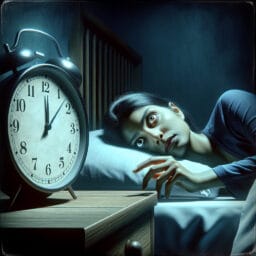
Understanding the Multiple Sleep Latency Test (MSLT): Definition and Procedure
Table of Contents
- Introduction
- Definition of MSLT
- Procedure of MSLT
- Interpretation of MSLT Results
- Conclusion
- Frequently Asked Questions
Introduction
Examining the world of sleep disorders, we find a variety of scientifically-backed tests and tools to diagnose these conditions accurately. Among them, the Multiple Sleep Latency Test (MSLT) emerges as an innovative solution that precisely measures how quickly one can fall asleep in quiet environments. This sleep study has its roots in a simple question – How fast does one succumb to slumber during their waking hours? Administered by a board-certified sleep medicine physician or a trained sleep technologist, MSLT involves scheduled naps throughout the day under the watchful eyes of low-light video cameras that transmit data about your brain waves, eye movements and other vital signs relevant to your sleep quality.
Commonly known as a ‘nap trial’, this test is pivotal in diagnosing disorders like narcolepsy type 1 and idiopathic hypersomnia, where patients tend to be excessively sleepy during daytime hours despite adequate rest at night. The process entails five nap opportunities spread across every two hours post an overnight sleep study at a certified sleep center. Patients are expected to lie quietly without trying hard to remain awake or fall asleep fast. Detailed records from this daytime nap study not only reveal how easily patients enter REM sleep but also offer insights into instances where they may experience sudden uncontrollable bouts of falling asleep known as ‘sleep attacks’.
Remember, understanding these aspects of our slumber can open doors for effective treatment strategies promoting healthier sleeping patterns and overall well-being.
Definition of MSLT
In the realm of sleep disorders, diagnosing conditions like narcolepsy type and idiopathic hypersomnia necessitates an intricate ride through our sleep cycle. Enter the Multiple Sleep Latency Test (MSLT), a specialized ‘nap trial’ that provides crucial insights into our sleeping habits. Imagine a quiet environment in a certified sleep center where an individual dozes off under the observation of low-light video cameras. These cameras don’t just observe, they transmit data about one’s eye movements, brain waves, and more to provide an intimate portrait of their slumber quality. The MSLT doesn’t merely clock how fast one can fall asleep; it plunges deeper to unearth root causes behind excessive daytime sleepiness.
An overnight sleep study precedes this nap study and feeds valuable information for subsequent analysis. Once completed, patients are offered multiple nap opportunities during their waking hours with scheduled naps every two hours. These ‘sleep episodes’ are geared to reveal not only whether patients enter REM sleep quickly but also if they are unusually sleepy during daytime despite adequate rest at night – hallmarks of conditions such as narcolepsy or idiopathic hypersomnia.
While lying quietly without battling to remain awake or fall asleep fast might seem simple enough, it’s vital in assessing central disorders involving abnormal control of REM sleep. As each nap trial begins, a trained sleep technologist gently places sensors that record vital signs aiding in comprehensive analysis post-MSLT completion by board-certified physicians specializing in Sleep Medicine.
Navigating your way through results might feel daunting but remember you have allies – your dedicated Sleep Doctor will guide you through understanding MSLT results while providing targeted treatment strategies for any diagnosed conditions like idiopathic hypersomnia or potential causes behind persistent daytime tiredness such as undiagnosed obstructive sleep apnea.
The journey towards healthier slumber begins with understanding these tests and what they entail – empowering yourself with knowledge is the first step on this path.
| Term | Definition |
|---|---|
| MSLT | Multiple Sleep Latency Test – a specialized ‘nap trial’ that provides crucial insights into our sleeping habits |
| Sleep Center | A certified facility where an individual dozes off under the observation of low-light video cameras. These cameras transmit data about one’s eye movements, brain waves, and more. |
| Overnight sleep study | A study that precedes the nap study and provides valuable information for subsequent analysis |
| Sleep episodes | Multiple nap opportunities offered to patients during their waking hours with scheduled naps every two hours |
| Sleep technologist | A trained professional who places sensors that record vital signs aiding in comprehensive analysis post-MSLT completion |
| Sleep Medicine | A medical specialty involving the diagnosis and therapy of sleep disturbances and disorders |
| Sleep Doctor | A specialist who guides patients through understanding MSLT results while providing targeted treatment strategies |
| Idiopathic hypersomnia | A condition characterized by excessive sleepiness during daytime despite adequate rest at night |
| Obstructive sleep apnea | A potential cause behind persistent daytime tiredness, often undiagnosed |
Procedure of MSLT
It’s interesting to note that sleep disorders, often overlooked, can significantly impact a person’s quality of life. Diagnosing these intricate conditions requires innovative tools like the Multiple Sleep Latency Test (MSLT), widely recognized as an effective measure of daytime sleepiness. The MSLT takes place usually after an overnight sleep study at a certified sleep center. This meticulously scheduled ‘nap trial’ allows patients multiple opportunities to doze off during waking hours in a quiet environment under the surveillance of low-light video cameras that transmit data on their eye movements and brain waves.
Preparation for this test is straightforward yet critical. A drug test may be necessary to ensure no substances could influence the outcomes. Patients are also encouraged to keep a detailed sleep diary leading up to the MSLT, documenting their sleeping habits and any instances of excessive daytime sleepiness or trouble staying awake.
Once prepared, patients undergo this nap study where each nap opportunity begins with sensors gently placed by a skilled sleep technologist who monitors various parameters throughout the process. These sensors record vital information about REM sleep stages and other physiological signs relevant to diagnosing potential disorders such as idiopathic hypersomnia or narcolepsy type 1.
What makes this procedure unique is how it quantifies one’s ability to fall asleep easily in conducive environments while remaining wakeful in others – essentially measuring your ‘sleep latency.’ From understanding how quickly you enter REM sleep to decoding if you’re unusually sleepy during day hours despite ample nighttime rest, MSLT offers invaluable insights into your slumber patterns.
Undoubtedly, interpreting these results requires expertise! A board-certified Sleep Medicine physician or ‘Sleep Doctor’ assesses your recorded data intricately post-MSLT completion. Their role extends beyond just diagnosing possible central disorders; they guide you through understanding your results and offer tailored treatment strategies designed around your specific needs.
Remember: whether it’s battling excessive daytime tiredness caused potentially by undiagnosed sleep apnea or managing conditions like idiopathic hypersomnia, the MSLT proves a reliable tool in your journey towards healthier sleep!
Interpretation of MSLT Results
In the complex realm of sleep disorders, understanding test results can often be as challenging as diagnosing the condition itself. This is particularly true in the case of a Multiple Sleep Latency Test (MSLT), an innovative ‘nap trial’ designed to measure one’s ability to fall asleep easily during daytime hours. What does it mean when an individual falls asleep fast? Interpreting MSLT results requires more than just assessing how quickly one succumbs to slumber; it involves decoding specific aspects such as ‘sleep latency’, ‘enter REM sleep’, and ‘sleep stages’.
Sleep latency refers to the time it takes for an individual to transition from being fully awake to sleeping, which becomes notably shorter in conditions like idiopathic hypersomnia or narcolepsy type 1. Meanwhile, entering REM sleep rapidly might indicate a propensity for central disorders involving abnormal control of REM sleep. Furthermore, analyzing different sleep stages gives insights into any disruptions that may contribute to excessive daytime sleepiness despite adequate nighttime rest.
Understanding these factors aids a board-certified Sleep Medicine physician or ‘sleep doctor’ in tailoring treatment strategies that address not just symptoms like trouble staying awake but also underlying issues affecting overall sleep quality. With each nap opportunity carefully monitored by skilled technologists using low-light video cameras and sensors transmitting vital data about brain waves and eye movements, every aspect contributes valuable insights towards achieving healthier sleeping patterns. Remember, knowledge isn’t merely power – when it comes to managing your slumber health effectively, it’s essential.
| Term | Explanation | Implications |
|---|---|---|
| Multiple Sleep Latency Test (MSLT) | An innovative ‘nap trial’ designed to measure one’s ability to fall asleep easily during daytime hours | Helps identify conditions that affect one’s ability to stay awake during normal waking hours |
| Sleep Latency | The time it takes for an individual to transition from being fully awake to sleeping | Shorter sleep latency could indicate conditions like idiopathic hypersomnia or narcolepsy type 1 |
| REM Sleep | A stage of sleep where Rapid Eye Movements occur | Rapid entry into REM sleep could indicate a propensity for central disorders involving abnormal control of REM sleep |
| Sleep Stages | Distinct stages that the brain and body go through during sleep | Analyzing these can provide insights into disruptions that cause excessive daytime sleepiness despite adequate nighttime rest |
| Sleep Medicine Physician/Sleep Doctor | A board-certified physician who specializes in sleep disorders | Understanding sleep results can aid in tailoring treatment strategies that address not just symptoms but also underlying issues affecting overall sleep quality |
Conclusion
An alarming number of individuals grapple with sleep disorders, their waking hours marred by excessive daytime sleepiness. They could be wrestling with conditions like narcolepsy type 1 or idiopathic hypersomnia without even knowing it. The key to unlocking these mysteries of the mind and body lies in a comprehensive approach to diagnosing such disorders – this is where the Multiple Sleep Latency Test (MSLT) comes into play. Not merely a ‘nap trial’, MSLT provides multiple opportunities for patients to fall asleep during scheduled intervals under controlled conditions in a certified sleep center. Here, equipped with sensors that transmit data on brain waves and eye movements, trained sleep technologists dive deep into understanding your sleep latency – how quickly you can transition from being awake to falling asleep fast. It’s not uncommon for those undergoing MSLT to enter REM sleep rapidly, another crucial sign of potential central disorders at play that’s captured meticulously during this test. With results analyzed in detail by board-certified specialists in Sleep Medicine, MSLT serves as an invaluable tool towards bettering your overall sleep quality.


